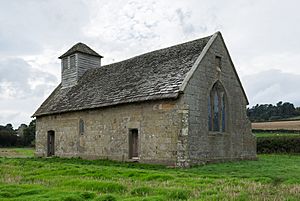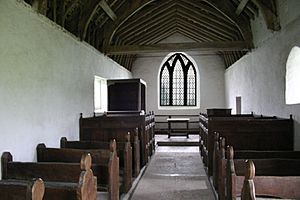Langley Chapel facts for kids
Langley Chapel is a special church in England. It was built a long time ago, in 1601. You can find it in a quiet, countryside area in Shropshire, about 1.5 miles south of Acton Burnell.
This church is looked after by English Heritage. It's famous because it still has all its original wooden furniture from the 1600s! It's also unusual because it doesn't have a separate area for the altar, which is called a chancel. This design was common for smaller churches and fit with the way people worshipped back then.
Langley Chapel is one of the very few new churches built in England during the time of Queen Elizabeth I. Even though it was built in the early 1600s, some of its windows look like older Gothic styles. The doors are simple, one is flat at the top and the other is rounded.
A Look Back in Time
Langley Chapel was built where an even older church used to stand. It was used by people who lived at Langley Hall, a large house nearby. Today, only the ruins of Langley Hall remain on a private farm.
The chapel was built with wooden box pews, which are like enclosed seating areas. It also had a special desk for musicians and benches around the Communion table. We don't know what saint or event the chapel was named after.
Why Langley Chapel is Special
In the 1800s, Langley Hall disappeared, and fewer people lived in the area. Because of this, the chapel stopped being used. But this was actually a good thing!
In 1914, Langley Chapel became one of the first buildings to be protected by the government. Since it was left alone for so long, it was never changed or modernized. This means it's like a "time capsule" that shows us exactly what a church looked like in the 1600s. It's a rare and important piece of history.
It is also a Grade I listed building, which means it's considered a very important historical building in England.
See also



